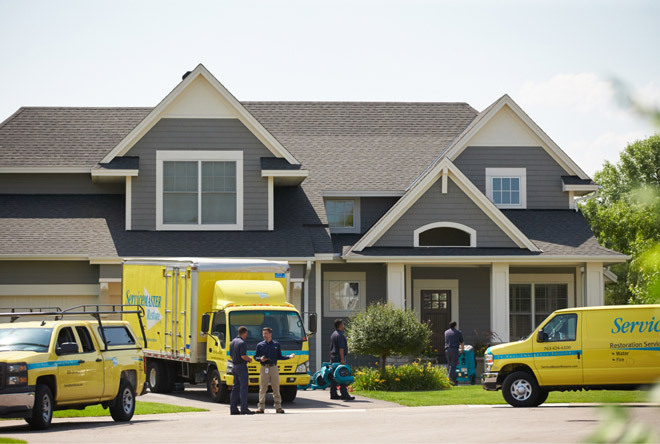Frozen Pipes & Sprinkler Heads
The frigid temperatures can make life in the winter difficult, especially when it gets cold enough to freeze the pipes in your plumbing system. It can be difficult to prevent your pipes from freezing because they are normally in poorly heated areas like attics, basements, and crawlspaces and if the water within a pipe or fixture freezes, there is a good chance a burst will follow. Burst pipes or sprinkler heads can cause immense damage by leaking a large amount of water into the home. ServiceMaster Restoration by Complete can remove water caused by a burst pipe or sprinkler head in homes and businesses and restore the resulting damage. Our technicians are trained experts in water damage restoration and we have the right equipment to handle large-scale water damage from a burst pipe.
The Freezing of Pipes and Sprinkler Heads
The plumbing system in a typical home or building often has pipes running through uninsulated areas which makes frozen pipes very likely with below-freezing temperatures. Freezing water inside the pipes will continue to expand and the pressure it puts on the pipe will eventually cause it to burst. Pipes leading up to fixtures like indoor sprinkler heads can also burst and cause damage to the fixture. Pipe bursts must be treated as an emergency because hundreds of gallons of water can spill out into your home in a very short time.
If you experience a pipe burst in your home or building, shut off the main water supply immediately to stop the leak and call our experts to handle the problem. We are trained and equipped to handle large-scale water damage and we will quickly clean up the spill from a burst pipe or broken sprinkler head before it causes serious damage or mold growth. Once the water has been removed and the affected materials are dry, we will clean and disinfect the area to return it to its previous condition.
How to Prevent Frozen Pipes
Dealing with the type of water damage that results from a burst pipe is a major inconvenience which is why you should take steps to prevent frozen pipes in the winter. The following are effective ways to prevent frozen pipes:
- Turn the hot and cold water valves on at each faucet so there is a constant light trickle. The water is less likely to freeze in the pipes if there is constant movement.
- Open base cabinets under your bathroom and kitchen sink to allow the heated air to warm the pipes. You can also consider keeping the pipes under the sink warm with a space heater.
- Cover pipes in uninsulated areas with pipe insulation or electrical heating tape.
- Try to warm up uninsulated areas with a space heater.
- Turn off the outside water supply and make sure you bring your hoses inside.

Locating Frozen Pipes
If there is a frozen pipe somewhere in the supply line, you must get to it immediately and thaw it out before it has a chance to burst. One of the most obvious signs of a frozen pipe is low water pressure. Follow these steps to find a frozen pipe in your home:
- Turn on each faucet and check the water pressure to find the supply line with the frozen pipe.
- Turn on a faucet in the supply line and keep it running.
- Follow the supply line from the faucet through the rest of the building to find the frozen pipe.
- Check for frost or ice on the pipes and bugles or fissures.
How to Thaw Frozen Pipes
After finding the frozen pipe, start thawing it right away before it has a chance to burst. If the frozen pipe is exposed or easy to access, try thawing it out with a hair dryer or heat lamp. First, turn on one of the faucets in the supply line to relieve the pressure, and then use the hair dryer to heat up the frozen area. Continue drying the supply line and work your way back to the faucet. Flame torches are not a good option to thaw frozen pipes because they are a fire hazard. If the frozen pipe cannot be accessed directly, you can take one of the following approaches:
- Turn up the heat in the home or building to warm the pipes.
- Heat the wall closest to the pipe with an infrared heat lamp. These lamps can heat the pipes directly because the heat does not get absorbed into the air.
- Take out the wall or ceiling in the way and use a hair dryer to thaw the pipe.
Frozen pipes and sprinkler heads are a real problem in the winter so make sure you take preventative action when the temperature drops. As soon as a pipe bursts in your home or business, shut off the water and contact ServiceMaster Restoration by Complete. Our water damage restoration experts will clean up the mess and make sure the area is fully restored. You can call us 24 hours a day at (732) 800-5717 for emergency response to a burst pipe.


